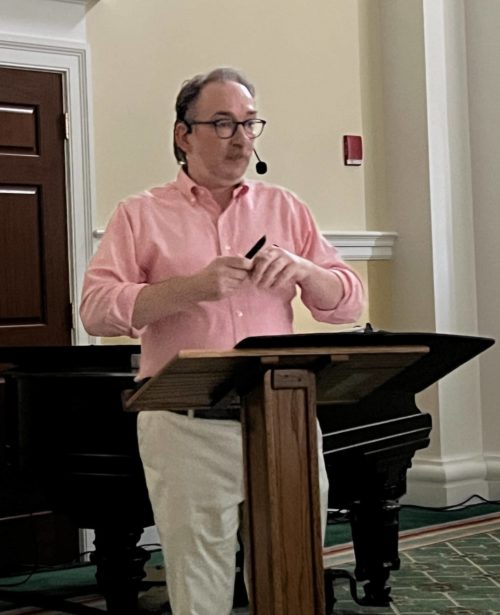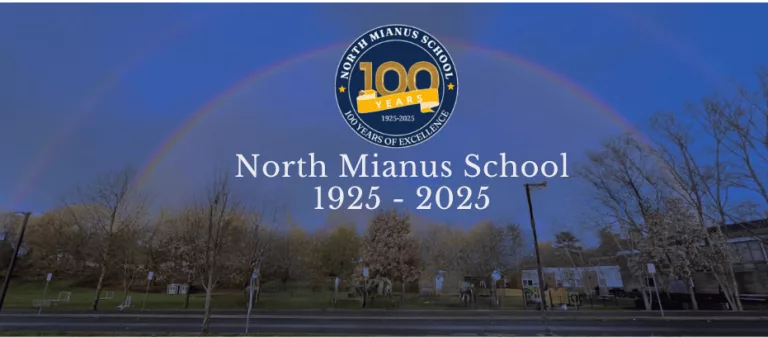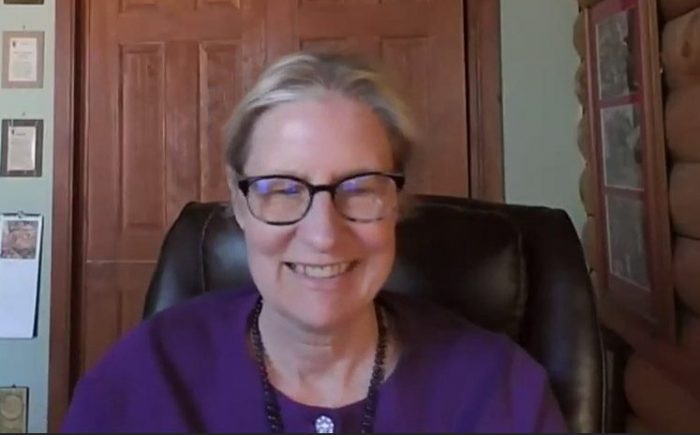By Frank Scarpa

At the July 24 meeting of the Retired Men’s Association Bob Rimmer introduced the speaker, renowned architect Phillip James Dodd. Born and raised in the United Kingdom, Dodd is an alumnus of the Prince of Wales’ Institute of Architecture in London. He moved to America more than 20 years ago, and founded his design firm Phillip James Dodd Bespoke Residential Design, LLC, in 2015. His designs can be found in New York, Greenwich, the Hudson Valley, Palm Beach and as far away as Bangalore, India. He has a master’s in architecture from the University of Notre Dame and an undergraduate degree from the Manchester School of Architecture. He is a Fellow Emeritus of the Institute of Classical Architecture & Art, and serves as a commissioner of the Town of Greenwich Historical District Commission. He is the author of several best-selling books on architecture. His latest, “An American Renaissance: Beaux-Arts Architecture in New York City” (2021) has a foreword penned by Julian Fellowes, creator of the HBO TV Series “The Gilded Age,” and is the basis for today’s lecture.
“Beaux-Arts” architecture may be traced back to the 19th century architecture school in Paris. “American-Beaux-Arts” got its kick-start at the 1893 World Columbian Exposition in Chicago. “The White City,” as this exhibition was called, was visited by 25% of the U.S. population. The exposition featured some 200 new but temporary buildings in a celebration of the 400th anniversary of Columbus’ arrival in the New World. Many visitors returned home enthralled by this new form of architecture.
Mr. Dodd then proceeded to outline the history of America’s “Gilded Age,” which extended to the late 1890s, illustrated by iconic photographs of lavish edifices. He began with the Biltmore Estate in Asheville, North Carolina. Built by George Vanderbilt, and still standing, this is the largest home built in the U.S. The style was replicated in the Marble House and the Breakers (in Newport) and New York’s Astor Mansion (1896).
The Samuel Tilden House in New York boasted a reflective glass ceiling designed by John LaFarge. Tilden also played a key role in foreseeing The New York Public Library (1911). Photographs of elegant buildings, some no longer extant, were used by Mr. Dodd to enliven the history of the monied class and their rivalries and jealousies. Many magnificent homes had been built as “spite homes”–i.e. one magnate trying to upstage a rival. The Astor Mansion and the Frick House entered into the discussion. The talk was replete with details about Andrew Carnegie and Otto Kahn, who was second only to J.P. Morgan in wealth, and their edifices. Kahn’s Oheka Castle (Long Island) and Lyndhurst (Tarrytown) are still standing.
One interesting detail about New York’s high society of the time involves Caroline Astor’s creation of “The 400.” This involved her selection of a specific number of people whom she considered her peers in “fashionable society.” It is said that this number was chosen based upon the number of guests who could be accommodated in Lady Astor’s ballroom. (However, when the Astors later moved to larger quarters, the 400-person limit was retained.) Mr. Dodd’s colorful tale even takes us to Woodlawn Cemetery and the ornate mausoleum of Jay Gould, who was much reviled as having been responsible for the financial panic of “Black Friday,” 1869.
Much of this history is colorfully reprised in Julian Fellowes’ “The Gilded Age,” which is available on Amazon. Mr. Dodd cautions that some of the names have been altered and there is some “artistic license” taken in the film. This lecture certainly whets our appetites to dig deeper.
The talk can be viewed by going to the RMA website at https://greenwichrma.org, and clicking on “Speakers.”
The RMA’s upcoming presentation, “Judy Garland: Moments of Magic,” by Lawrence Schulman, is scheduled for 11 AM on Wednesday, August 7, 2024. Music producer, critic, translator, and author Lawrence Schulman will examine Judy Garland’s life and career in a talk designed to answer the question: “If I had just one hour to convince you of Judy Garland’s place in classic American popular music, what film and television performances would I choose?” Instead of taking a birth-to-death historical approach, he will provide a brief biography, but will also present audio/video clips of some of Garland’s greatest moments on film, radio, and TV, providing a brief introduction for each. His goal is to allow the audience to experience Garland at her peak.
Schulman, a graduate of Stony Brook University, the Sorbonne, and CREAR, a school for film and video studies in Gouvieux, France, is a music producer, critic, and translator who has compiled numerous CD sets devoted to Judy Garland. His talk on Garland, “Moments of Magic,” has been heard in New York, Boston, and various venues in Maine, where he resides. While living in Paris between 1971 and 1997, he taught and translated, and he currently translates for the French website OpusHD.net. During his Paris years he also worked for French Public Radio as a producer and host. He has written reviews and articles for the ARSC Journal since 1994. His most recent CD/LP is “Judy Garland – A Celebration” (2024). His translation from the French of Bertrand Tessier’s “Judy Garland: Splendor and Downfall of a Legend,” for which he also provided a foreword, was published in early 2023 and his own two-volume book, “Garland–That’s Beyond Entertainment – Reflections on Judy Garland,” was published in late 2023 by BearManor Media. His most recent book is “FREE: Words on Music by a Hi-Def Critic in an MP3 World,” which contains his non-Garland writings. He is currently working on a book on Peter Allen, which will be published in 2025.
To stream the presentation by Lawrence Schulman at 11 AM on Wednesday, August 7, click on https://bit.ly/30IBj21. This presentation will also be available on local public access TV channels, Verizon FIOS channel 24 and Optimum (Cablevision) channel 79.
The public is also invited to attend the presentation in person. This presentation will be held not at our normal location but at Christ Church, 254 East Putnam Avenue, in Greenwich.
Note: The views expressed in these presentations are those of the speakers. They are not intended to represent the views of the RMA or its members.
RMA speaker presentations are presented as a community service at no cost to in-person or Zoom attendees, regardless of gender. Any member of the public who would like to receive a weekly email announcement of future speakers should send a request to members@greenwichrma.org. The RMA urges all eligible individuals to consider becoming a member of our great organization, and thereby enjoy all the available fellowship, volunteer, and community service opportunities which the RMA offers to its members. For further information, go to https://greenwichrma.org/, or contact members@greenwichrma.org.




